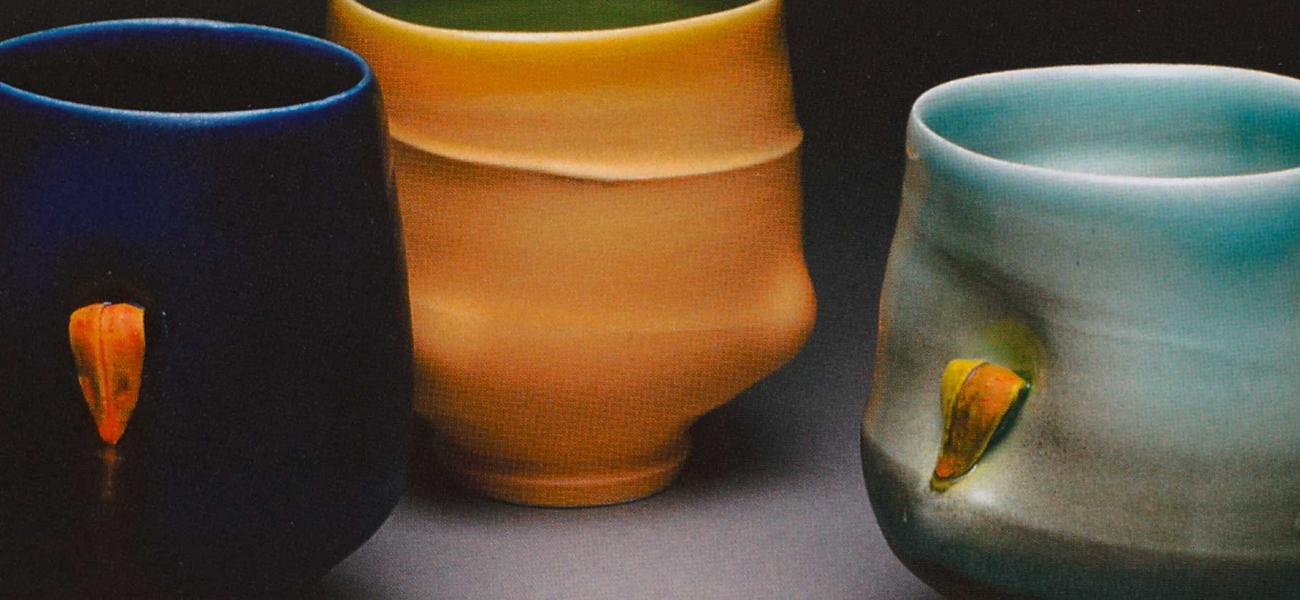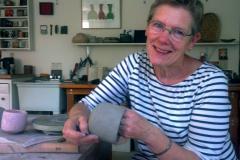Intent: Potters and the Electric Kiln
The elements do hum as they cycle off and on. And at night in the studio, an intense line of orange-yellow-white glows beneath the rim of the kiln. But the romance of firing has eluded the electric kiln, and the passionate conversation that rages around other ceramic processes has bypassed it. Indeed, it sometimes seems that there is nothing to say. Long associated with the hobbyist and the housewife, and touted mainly for its convenience and low-tech accessibility, the electric kiln as object and experience has inspired no symposia, no poetry, no imaginative bonding with potters of the past. Although (or perhaps because) it is so thoroughly a 20th-century technology, it has flown under the radar of contemporary ceramic discourse. Outside industrial settings, most of the ceramic objects made today are probably fired in electric kilns, yet the effect of this type of firing on the objects made, the ideas behind them, or the people making them is rarely discussed. An unexamined assumption prevails that firing in the electric kiln is a non-process, characterized by absence: of atmosphere, of risk, of mystery, of any meaningful encounter.
People who work with clay accept the need to navigate between their ideas and the physical nature of clay processes. Unpredictability is always a factor, complete control an illusion better suited to other media, and mastery a carefully honed tool. The random elements are also a tool, acknowledged or not, and finding one's voice in clay involves a very personal search for the ideal balance between the aspects of the work that come from one's own intention and skill and those that are bestowed by clay or fire. For many potters, and they are well represented in the literature, combustion - the smokier the better - is an essential element in the work's fruition, adding both visual richness and an undefinable juicy mystery. But working away in their studios are people just as engaged in making firing serve their work, using electric kilns. We haven't heard much from them about how the kiln figures in their ideas, and so the notion persists that the electric kiln has no active role. Perhaps, though, it is truer to say that the balance between what the potter contributes and what the kiln does is different. If atmospheric firing requires that potters accept the unpredictable effects it will have on their work - plan for them and make room for them - then electric firing requires a different, more proactive, relationship to what goes on inside the kiln. Some temperaments, and some types of work, take to this more naturally; uniform color and the faithful transmission of intricate decoration are the forte of the kiln's neutral atmosphere. But it is also possible to orchestrate melt, crystal development, or flashing, and to create surprise and volatility. A look at the range of work coming out of electric kilns suggests that what links its makers is neither an esthetic nor a philosophical stance, but a willingness to take on the entire fired surface, whether that means tightly-controlled placement of imagery or an orchestrated interplay of materials.
The articles that follow articulate the thinking of some of the many potters who use the electric kiln to finish their work. For the most part they concern not the "how" of electric firing, but the "why," exploring that question beyond the obvious factors of convenience and mobility. All have learned to work with the variables at hand, observing and experimenting and tweaking, to create not only the desired surface effects but also the conditions for some event that carries their ideas across the threshold of transformation. In other words, they don't just turn the knobs, they fire their kilns, and consider the interplay of concept, form, and surface with the particulars of the electric kiln in mind.
Ongoing and evolving engagement is at the heart of these essays. In most cases it has taken place against a backdrop of what might be called the "culture of fire": the assumption that authentic pottery- making must involve a primal encounter not only with heat, but also with flame. The recur ring traces of reluctance shows how thoroughly and disproportionately this culture has dominated contemporary thinking about what it means to work in clay. It is worth pointing out, though, that this is a North American view; had the scope of these articles been expanded to include prominent European and Asian ceramic artists, there would be little mention of firing process as a distinguishing feature of the work. Undoubtedly, this is changing here too as serious potters who also teach expose their students to their methods and articulate this option for a new generation. But thoughtful examination of the issue, either technical or esthetic, has lagged behind the reality of many potters' actual situations.
The challenges imposed by the electric kiln recreate a very old situation with a very modern instrument. Until quite recently, working with clay meant using the fuel and firing method locally available, and learning not only to accept their limitations (for there were no other options), but to understand and push against them. Potters have worked in this narrow but fruitful way for thousands of years. In our modern age of proliferating options, electric kilns often begin as a fallback, one that limits our luxurious sense of choice, undermines our romantic reliance on the fire's blessing, and forces us to resolve and answer for every aspect of our work. That in turn makes us consider, first, our ideas, and then the tools available to bring them to fruition. What emerges out of this predicament is the fundamental ceramic dance of technology and intent.
Other Articles in the "Intent: Potters and the Electric Kiln" Series
Richard Zakin, "A History of the Electric Kiln"
Stanley Mace Andersen, "Economics, Esthetics, and the Electric Kiln"
Ann Gabhart, "Thinking Electric"
Geoffrey Wheeler, "The Kiln Gods are Dead"
John Hesselberth, "Computer Controlled Electric Kilns - A Toy or a Tool"
Lisa Naples, "Transition, Tradition, and Technology"
Mark Pharis, "Inside the Box"
Richard Zakin, "Using the Electric Kiln"
Mary Barringer, "Technical Notes"


